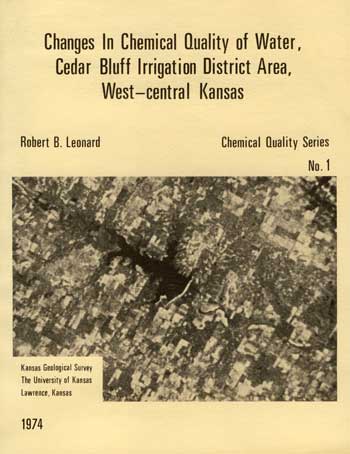Changes In Chemical Quality of Water, Cedar Bluff Irrigation District Area, West-Central Kansas
by Robert B. Leonard

Originally published in 1975 as Kansas Geological Survey Chemical Quality Series 1. This is, in general, the original text as published in 1975. The information has not been updated. This publication is also available as an Acrobat PDF file (2 MB).
Abstract
The Cedar Bluff Irrigation District diverts water from the Smoky Hill River to irrigate about 6,000 acres (2,400 hectares). Although drainage from irrigated land replenishes ground water in transient storage and augments low flow in the river, the drainage adversely affects the chemical quality of the related water. Specific conductance of the irrigation water increased progressively from 800 to 980 micromhos per centimeter at 25°C between 1964 and 1971. The percent composition of this calcium-sulfate type water remained relatively constant.
Infiltration of the irrigation water, which contained additional salts leached from the soil, increased the concentration and changed the ionic composition of the ground water. Generally, calcium and sulfate became the predominant ions. Concentrations of calcium, magnesium, and sulfate present in the irrigation water were augmented by the natural content in the soil and the aquifer. Chemical analyses of soil samples indicated that significant amounts of sodium and chloride were leached from naturally accumulated salts in the soil. Increased concentrations of nitrate probably resulted from applying water in excess of that required by the fertilized crop.
Data from seepage-salinity surveys indicate that water discharge of the Smoky Hill River in the irrigation reach increased progressively from about 1.5 to 10 cubic feet (0.04 to 0.28 cubic meters) per second between 1964 and 1971. Specific conductance in the reach increased from 880 to 900 micromhos per centimeter at 25°C in 1964 and from 1,070 to 1,230 micromhos per centimeter at 25°C in 1971. The concentration ratios for specific conductance increased from 1.01 in 1964 to 1.15 in 1971. Concentrations of sodium and chloride increased downstream, but the concentration of sulfate decreased to values lower than that of the irrigation water. Although net gains in chemical discharge increased from 1964 to 1971, the rate of annual increase diminished from year to year.
The use of water for irrigation in the district and the increase of drainage to low flow have not caused serious degradation of chemical quality of the Smoky Hill River.
Kansas Geological Survey, Geohydrology
Placed on web Nov. 2012; originally published 1975.
Comments to webadmin@kgs.ku.edu
The URL for this page is http://www.kgs.ku.edu/Publications/Bulletins/CQS1/index.html